Memphis' Ryan Silverfield claps back at UTSA's Jeff Traylor over NIL comments

In October 2024, ahead of a matchup against Memphis, UTSA coach Jeff Traylor discussed the difference in NIL funds between the two programs. He said the Tigers’ roster cost “six times more” than the Roadrunners’.
During an appearance on The Chris Vernon Show on Wednesday, Memphis coach Ryan Silverfield responded. He pointed to Traylor’s contract extension at UTSA.
In March, Traylor inked a contract extension through 2031, worth $28 million. Silverfield joked he should give a portion of it back to UTSA, but also noted the result of that October matchup. Memphis fell 44-36 in a game that proved costly in the American Athletic Conference race.
“Which I think is unique because that head coach signed a $27 million contract,” Silverfield said when Traylor’s comments came up in conversation. “He should probably give some of that money back to the school, right?
“… They beat us, so I can’t say much. He’s a good coach and he’s done a good job with that program. But people are always going to say that. It’s the easy thing.”
Memphis got major support from FedEx last year when the company committed $25 million over the next five years to the school’s NIL efforts. As part of the deal – facilitated by Altius Sports Partners – the funds will be allocated across football, men’s and women’s basketball, and other women’s programs.
Silverfield acknowledged the deal with FedEx, but also pointed out Memphis’ track record with development. He specifically pointed out Seth Henigan, Roc Taylor and Caden Prieskorn as some players developed by the Tigers before eventually heading to the NFL.
Top 10
- 1New
Bobby Petrino
Adds NFL asst. to Arkansas staff
- 2
Senator Paul Finebaum?
Tommy Tuberville reacts
- 3
YouTube TV - NBC
Resolution reached
- 4Hot
Ed Orgeron
Addresses coaching future
- 5Trending
SEC Champ Prediction
Joel Klatt makes the call
Get the Daily On3 Newsletter in your inbox every morning
By clicking "Subscribe to Newsletter", I agree to On3's Privacy Notice, Terms, and use of my personal information described therein.
“I remember Rhett Lashlee would say, everybody’s always just talking about that we’re getting players because of the money at SMU,” Silverfield said. “In reality, at some point, you’ve got to coach. Seth Hennigan, did we do a good job developing him? Or did he come to Memphis for the money? Let’s just call it what it is. Rock Taylor, got him out of high school. … Let’s just call it what it is. These are kids that were developed and moved on.
“But yes, look, the university, the president and the board, Ed Scott, they’ve all done a fantastic job. Obviously, FedEx has been instrumental in our success. I don’t hide from that.”
How rev-sharing could impact AAC teams
The college sports world is gearing up for a new era following House v. NCAA settlement approval. Revenue-sharing is on the way, with schools able to share up to $20.5 million directly with athletes starting July 1.
That shift will mean players will be able to receive dollars directly from universities. But for schools in the AAC such as UTSA and Georgia State, Ryan Silverfield thinks they could be in stronger position than some think because of the revenue streams they have in place.
“Everybody would say, ‘Well, can Georgia State have any money?'” Silverfield said. “Well, if they have 50,000 students and they’re taking $300 a semester from each student for student fees – which goes directly back into athletics – that’s a good chunk of change that a 20,000-student university that doesn’t charge student fees can’t catch up with.”